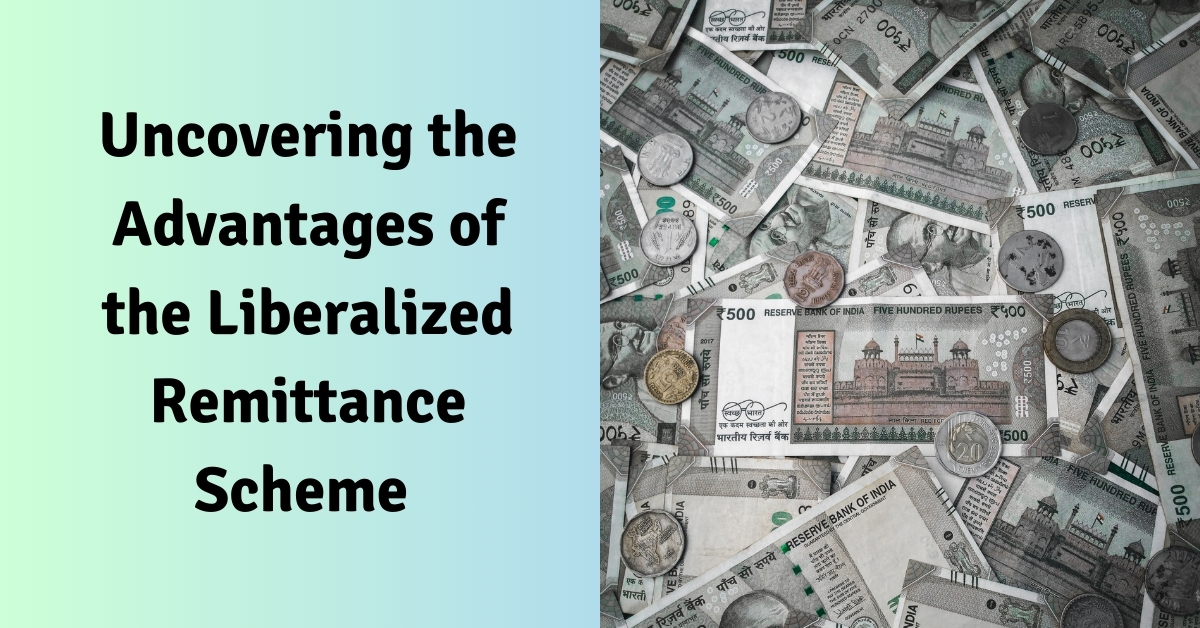Uncovering the Advantages of the Liberalized Remittance Scheme

Essential Roles and Significance of Fund Transferors in Cross-Border Financial Transactions
Consider a scenario where Anita, a young professional in India, wishes to invest in her relative’s startup in the United States. Traditionally, international money transfers involve complex paperwork and substantial fees.
Enter the Liberalized Remittance Scheme (LRS) – a revolutionary solution for individuals like Anita. Implemented by the Reserve Bank of India (RBI), the LRS has streamlined the process of sending money overseas, making it more accessible and user-friendly.
The significance of remittance schemes cannot be understated, particularly in our interconnected world where financial transactions frequently cross national boundaries. Whether for educational purposes, travel, investments, or supporting family abroad, the LRS provides a versatile and efficient solution.
In this article, we’ll explore the advantages, limitations, and significance of the Liberalized Remittance Scheme according to RBI guidelines.
Understanding the Liberalized Remittance Scheme (LRS) The Liberalized Remittance Scheme (LRS) is a crucial initiative launched by the Reserve Bank of India (RBI) in 2004 to facilitate outward fund transfers by Indian residents.
Designed to simplify the process of sending money abroad, the LRS enables individuals to remit a specific amount annually for various purposes, thus promoting financial flexibility and global integration.
Primary Features of the Liberalized Remittance Scheme
- Yearly Limit A key aspect of the Liberalized Remittance Scheme is the annual remittance limit.
Currently, the limit stands at USD 250,000 per individual per financial year. This limit encompasses all permissible current and capital account transactions, making it a versatile tool for managing international financial needs.
- Authorized Uses The LRS can be utilized for various purposes, including:
Education: Covering tuition fees, living expenses, and other educational costs abroad.
Travel: Paying for travel expenses, including accommodation and tours.
Medical Treatment: Funding medical expenses for treatments received overseas.
Investment: Purchasing shares, property, or other financial instruments in foreign countries.
Gifts and Donations: Sending money as gifts to relatives or as donations to charitable institutions abroad.
- Restricted Uses While the Liberalized Remittance Scheme offers extensive flexibility, certain transactions are prohibited. These include the following:
Remittance for trading in foreign exchange abroad. Direct or indirect investment in countries identified by the Financial Action Task Force (FATF) as non-cooperative. Remittance for purposes banned under Indian regulations, such as margin trading.
Advantages of the Liberalized Remittance Scheme- The Liberalized Remittance Scheme is available to individuals seeking a dependable and efficient method to manage their international financial affairs.****
The key benefits include:
- Adaptability and Ease of Use –
One of the primary advantages of the Liberalized Remittance Scheme is its remarkable adaptability and ease of use. The scheme allows individuals to remit funds up to the limit of USD 250,000 per financial year. This substantial limit accommodates a wide range of financial needs, such as:
Education: Students can easily pay tuition fees, living expenses, and other educational costs abroad without navigating complex financial procedures.
Travel: Travelers can fund their trips, covering costs like accommodation, transportation, and tours, enhancing their international experiences.
Medical Treatment: Individuals seeking medical treatment overseas can use the LRS to cover their expenses, ensuring access to quality healthcare globally.
- Financial Inclusion and Investment Prospects –
The Liberalized Remittance Scheme is available to individuals looking to diversify their investment portfolios. By allowing investments in foreign assets, the scheme promotes financial inclusion and opens up numerous investment opportunities, such as:
Foreign Stocks and Bonds: Investors can purchase shares and bonds in international markets, diversifying their portfolios and potentially enhancing returns.****
Real Estate: The scheme enables individuals to invest in properties abroad, providing opportunities for real estate diversification and potential capital appreciation.
Business Ventures: Entrepreneurs can invest in or support international business ventures, facilitating global business expansion and partnerships.
- Supporting Family and Lifestyle Requirements
Another significant advantage of the Liberalized Remittance Scheme is its ability to support family and lifestyle needs. The scheme allows for:
Family Support: Individuals can remit money to support family members residing abroad, ensuring their financial well-being.
Gifts and Donations: The scheme permits sending gifts to relatives and making donations to charitable institutions overseas, fostering goodwill and support across borders.
Lifestyle Enhancements: Whether it’s funding a child’s education, supporting a spouse’s career development abroad, or simply enjoying an international lifestyle, the LRS offers the financial flexibility needed to achieve these goals.
- Simplified Regulatory Adherence –
The RBI Liberalized Remittance Scheme is designed with user-friendly regulations that simplify compliance. Key aspects include:
Clear Guidelines: The RBI provides clear and comprehensive guidelines on the permissible uses of the scheme, ensuring that users can easily understand and adhere to the rules.
Streamlined Processes: The remittance process under LRS is streamlined, reducing the bureaucratic hurdles typically associated with international money transfers.
Compliance Support: Financial institutions offer robust support to individuals using the LRS, helping them navigate regulatory requirements and ensure compliance.
- Fostering Global Financial Integration –
The Liberalized Remittance Scheme goes beyond just transferring funds; it facilitates global financial integration. By allowing individuals to engage in international transactions, the LRS helps in:
Promoting Economic Connectivity: The scheme fosters economic connectivity between India and the global market, promoting trade and investment flows.
Cultural Exchange: Financial interactions under LRS often lead to greater cultural exchange and understanding, strengthening global relationships.
Economic Development: The scheme contributes to economic development both within India and in recipient countries by enabling investments and expenditures abroad.
Conclusion
****The Liberalized Remittance Scheme (LRS) by the Reserve Bank of India offers a flexible and efficient solution for managing international financial transactions. The scheme’s benefits are extensive, from supporting education and travel to providing investment opportunities and family support.
By simplifying the process and promoting global financial integration, the LRS stands out as a vital resource for anyone looking to engage in cross-border financial activities.
FAQs’
- What are the primary advantages of the Liberalized Remittance Scheme for individuals?
Ans- The Liberalized Remittance Scheme offers individuals a streamlined process for sending money abroad, allowing up to USD 250,000 per financial year for various purposes. It provides flexibility, reduces bureaucratic hurdles, and supports a range of financial needs such as education, travel, and investments.
- How does the Liberalized Remittance Scheme contribute to financial freedom and flexibility for investors?
Ans- The LRS allows investors to diversify their portfolios by enabling investments in foreign stocks, bonds, real estate, and business ventures. This financial freedom helps investors access global markets and seize international investment opportunities.
- How does the Liberalized Remittance Scheme promote international travel and education opportunities?
Ans- Under the LRS, individuals can easily fund their international travel expenses and education costs, including tuition fees and living expenses. This support enhances access to global educational institutions and enriches travel experiences.
- What role does the Liberalized Remittance Scheme play in fostering global citizenship?
Ans- The LRS facilitates cultural exchange and economic connectivity by enabling international financial transactions. It supports global citizenship by allowing individuals to invest in, support, and connect with the global community, promoting cross-border understanding and cooperation.
- Are there any limitations or restrictions imposed under the Liberalized Remittance Scheme?
Ans- Yes, the LRS has certain restrictions, including a maximum annual limit of USD 250,000 per individual. Additionally, it prohibits remittances for activities like trading in foreign exchange, investing in non-cooperative FATF countries, and purposes banned under Indian regulations.
- How can I make a remittance using the Liberalized Remittance Scheme?
Ans- To make a remittance under the LRS, you need to approach an authorized dealer (typically a bank) that offers remittance services. You will need to provide necessary documentation, such as proof of identity, the purpose of the remittance, and details of the recipient. The bank will process your request and ensure compliance with LRS regulations.
- Can the annual remittance limit be carried forward if not fully utilized?
Ans- No, the annual limit of USD 250,000 per individual cannot be carried forward. If you do not use the entire amount in a financial year, the unused portion will not be added to the limit for the next year. Each financial year starts with a fresh limit.
- What types of transactions are specifically excluded from the Liberalized Remittance Scheme?
Ans- The LRS excludes certain transactions, such as remittances for trading in foreign exchange abroad, investments in countries identified by the Financial Action Task Force (FATF) as non-cooperative, and transactions for margin trading or speculative investments.
- Are there any tax implications for funds remitted under the Liberalized Remittance Scheme?
Ans- Funds remitted under the LRS are subject to tax regulations in India. The remitter should ensure that the purpose of the remittance is compliant with Indian tax laws and report the remittance as required. It is advisable to consult a tax professional for guidance on tax implications related to your specific remittance.
- Can I use the Liberalized Remittance Scheme to remit funds to a bank account in my name outside India?
Ans- Yes, you can use the LRS to remit funds to a bank account in your name outside India. The scheme allows you to transfer money to your overseas account for various permissible purposes, including investments and personal expenses. Make sure to comply with all regulatory requirements and documentation as specified by the RBI.



